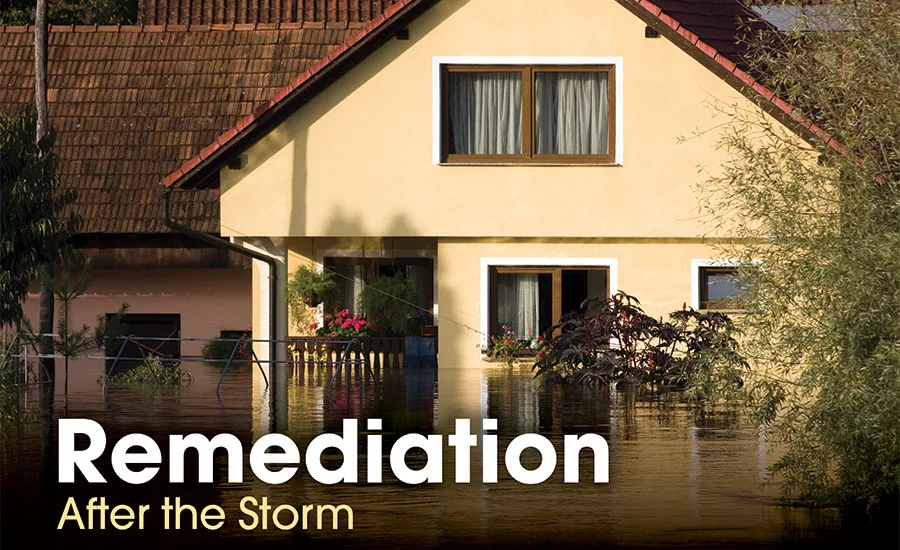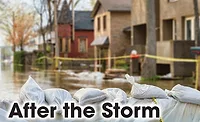Remediation After the Storm

Severe storms. Overflowing rivers. Coastal flooding. Tornadoes. Hurricanes Sandy, Katrina, Irma, ad nauseum. These days it seems as if the news is always carrying some story or another about our unpredictable weather ‒ and its disastrous after-effects. Whether (pun not intended) or not climate change is the root cause all these natural disasters is debatable. However, what is not debatable are the astonishing costs that these bad weather incidents wreak on the US economy.
According to the National Oceanic and Atmospheric Administration (NOAA), there have been three weather and climate disaster events in the first quarter of 2018, with losses exceeding $1 billion each across the United States. These events, the agency reports, included one severe storm and two winter storms, resulting in the deaths of 34 people, all of which had significant economic effects on the areas affected.1
The emotional and psychological toll
True, these statistics are attention-getting, but they tend to overlook the very human cost that these extreme weather events exact on your customers, new and old. The emotional and psychological toll the victims of these events undergo — to say nothing of the financial impact and the heart-breaking experience of seeing their homes severely damaged —̶is almost incalculable.
No one is expecting you to assume the role of counsellor and contractor, but assuming that they survive the worst of these storms, your customers will still be depending on you to handle the aftermath: the clean-up, in all its messy, dirty, and, quite possibly, dangerous, aspects.
Safety First
Whether the levee breaks or a storm surge inundates your customer’s house (or office), flooding can quickly overwhelm the best-maintained water purification and sewage disposal systems, which often results in garbage, assorted waste (even toxic waste sites and/or stored chemicals) finding their way onto your client’s property. While it’s true that the majority of most floods don’t not cause serious outbreaks of infectious disease or chemical poisonings, they can trigger sickness in those who come in contact with contaminated floodwaters — probably you and your workers for the most part! For instance, floodwater often contains infectious organisms, including intestinal bacteria such as E. coli, Salmonella, and Shigella; Hepatitis A Virus; and agents of typhoid, paratyphoid and tetanus. Plus, you and your crew may also have to contend with the electrical or fire hazards associated with downed power lines.
Even once the floodwaters have receded, any standing water and wet materials have been removed, and you have access to your customer’s property, make sure your workers put on protective equipment to protect their eyes, noses, mouths, and skin. This is especially true if your crew needs to use a wet vacuum to remove water from floors, carpets, and hard surfaces. Actually, you should make it clear to your clients that they should dry their home (or office) and everything in it as quickly as they can — within 24 to 48 hours, if possible! So, you have your work cut out for you.
One additional point: keep in mind that pools of standing or stagnant water that may accumulate around your customer’s property can become breeding grounds for mosquitoes, which can increase the risk of encephalitis, West Nile Virus or other mosquito-borne diseases. One more reason to wear those protective suits.

Before Starting Clean-up
A few tips before you begin the actual clean-up:
- Open all doors and windows when you are working and leave as many open as is safe when you leave.
- Open inside doors, especially closets and interior rooms, to let air flow to all areas. Take doors off their hinges if you need to.
- Open kitchen cabinets and bathroom vanity doors; remove drawers, wipe them clean, and stack them to dry.
- If, and only if, your electrical is safe to use, use fans and dehumidifiers to remove any moisture.
- Throw away anything that can’t be cleaned and dried and do it within 24 hours. Oh yes, and make sure that your customer gives you permission before you bin anything. Don’t make such decisions unilaterally!
Disinfect, Disinfect, Disinfect
The next step - and this one’s crucial - is to apply the most effective disinfectant and insecticide that you can. Obviously, there are so many different types of disinfectants available that it’s often difficult to know which ones will work best for your particular circumstances. Most have their advantages and disadvantages, but your best bet is likely a non-residual product that acts as both an insecticide and fungicide, like Sterifab disinfectant spray.
It is critical to choose a disinfectant with an antimicrobial agent that will kill many microorganisms on contact. Unlike antibiotics, which are designed to destroy microorganisms within the body, disinfectants like Sterifab work by destroying the microbes at the cellular level or by hindering their basic metabolic functions.
Applying a disinfectant is crucial to the remediation process. Even if there is no longer visible mold or mildew, tiny microbes may still be present. To ensure your safety in the long term, take the time to treat all affected areas.
Looking for a reprint of this article?
From high-res PDFs to custom plaques, order your copy today!




